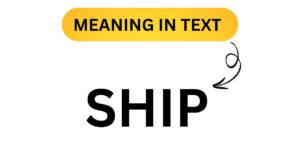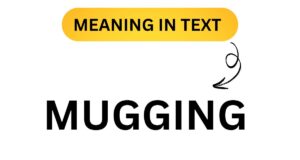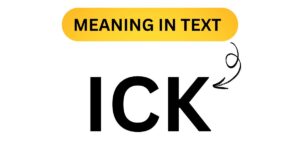You’re scrolling through social media, chatting with friends, or maybe even sending a quick text to your crush, when you come across a word: “NVM.” At first, you might think it’s some sort of secret code, or maybe you’re just missing a vital part of the language that the younger generation has completely mastered.
But then you realize, it’s not as mysterious as it sounds. NVM, my friend, is just shorthand for “never mind,” and it’s a slang term you’ll encounter often in our fast-paced, texting, emoji-filled world. But don’t worry – you won’t need to send a text back asking for clarification on this one!
In this article, we’re going to decode this seemingly cryptic term, explain how to use it in various situations, and give you some examples that’ll make you wonder why you didn’t start using it sooner. So buckle up – let’s dive into the wonderful world of “NVM”!
What Does NVM Actually Mean?
Let’s get the basics out of the way first. “NVM” is simply an abbreviation for the phrase “never mind.” It’s commonly used in texting, instant messaging, or casual conversations when you want to dismiss something, let go of an issue, or tell someone not to worry about what you just said or asked.
But don’t mistake it for “nah, I’m good” – it’s not quite as cool or dismissive as that (unless, of course, you use it with a sassy attitude). When someone types “NVM,” it’s often because something was misunderstood, they’ve changed their mind, or they want to gracefully exit a conversation.
So, the next time you’re on your phone or computer and you see someone drop an “NVM,” just know they’re signaling that they’re no longer focused on whatever was said before. Simple, right?
How and When Do You Use NVM?
Okay, now that we’ve got the definition down, let’s look at when and how you can use NVM in your own texting escapades. Trust us, once you understand the proper moments for using “NVM,” you’ll be a slang pro in no time.
Scenario 1: The Classic “Oops, Forget What I Said” Moment
We’ve all been there – you send a message, and almost immediately after hitting “send,” you realize that you either made a mistake or you’ve just asked a totally random question that doesn’t need an answer. Maybe you accidentally texted your boss to ask if they wanted to grab lunch when you meant to send that to your best friend. Oops. Instead of digging a hole and explaining yourself, a simple “NVM” saves you from further embarrassment.
Example: You: “Hey, do you want to grab lunch?” Boss: “Sure, when?” You: “NVM, I meant to text my friend about that. Sorry!”
In this case, NVM helps you backpedal without losing face. It’s like hitting the undo button on your brain.
Scenario 2: The Classic “Never Mind, I Changed My Mind” Moment
Sometimes you get into a conversation with someone, and halfway through, you realize it’s not worth the energy or you’ve completely changed your mind. Rather than continuing a long-winded explanation or discussion, just slap an “NVM” on there and let it go. This is an easy way to exit gracefully without seeming rude.
Example: You: “Do you want to go to that new Italian restaurant tonight?” Friend: “Sure! What time?” You: “NVM, I’m not in the mood anymore. Let’s just order pizza instead.”
This use of “NVM” is like a conversational exit strategy. It’s like saying, “Forget I mentioned it” without causing awkwardness.
Scenario 3: When You’ve Realized You’ve Already Got It Covered
Ah, the classic case of realizing that you’ve already solved your own problem mid-text. Maybe you asked a friend for advice on fixing your Wi-Fi, only to discover you’d already figured it out. Instead of dragging the conversation out, you hit them with a casual “NVM.”
Example: You: “How do I get my Wi-Fi to stop buffering?” Friend: “Have you tried restarting the router?” You: “NVM, I figured it out. It was the connection cable!”
This is basically saying, “Thanks for your help, but I’ve got it, no worries.” It’s polite, efficient, and keeps the conversation moving.
Common Misconceptions About NVM
Before you go around dropping NVM in every conversation, let’s clear up a few common misconceptions about the term, so you don’t accidentally come off as a confused teenager or, worse, a grumpy old person trying too hard to be “hip.”
Is NVM Rude?
Nope! NVM is generally not considered rude, but like all slang, context is everything. If you use NVM in the middle of an important conversation to shut someone down or dismiss them abruptly, it can come off as cold or dismissive. Just use it with the appropriate tone, and you’ll be fine. Keep it light and friendly – it’s a laid-back term.
Should You Use NVM in Professional or Formal Settings?
Not exactly. While NVM is perfectly acceptable in casual, friendly conversations, you probably want to steer clear of using it in professional emails or serious discussions. Using “NVM” with your boss or client could potentially make you seem unprofessional or immature. So, when in doubt, it’s better to just say “never mind” or explain yourself more clearly.
Is It Only for Texting?
While NVM is most commonly used in texting and online chatting, you can definitely use it in real-life conversations if you’re feeling particularly casual and comfortable with someone. You know, like those times you’re talking to a friend, and you just casually say “NVM” when you change your mind. But, like all slang, don’t overdo it. You don’t want to sound like a walking emoji.
NVM vs. Other Slang: A Quick Comparison
We know NVM is just one piece of the puzzle in today’s online communication landscape, so let’s quickly go over a few similar slang terms that might confuse you, too.
1. “LOL” – Laughing Out Loud
This one is pretty self-explanatory. While NVM is a response to an awkward situation, “LOL” is there to indicate that something is funny or amusing. You can use it when something’s actually laugh-worthy or, let’s be honest, just as a filler to keep the conversation alive.
Example: Friend: “I just dropped my phone in the toilet 😂” You: “LOL, classic!”
2. “BRB” – Be Right Back
This is one of those old-school internet abbreviations, but it’s still widely used. BRB means you’re stepping away from the conversation for a moment, but don’t worry, you’ll be back in no time.
Example: You: “I’ll be right back, I need a snack.” Friend: “BRB, I need to grab my charger.”
3. “IDK” – I Don’t Know
When you’re stumped or clueless (which, let’s face it, happens often), IDK is your go-to. It’s like your conversational shrug.
Example: You: “What’s the capital of Canada?” Friend: “IDK, but I think it’s Vancouver?”
While these terms are handy in their own right, NVM is the go-to option when you want to backpedal or let something slide without much fuss.
Why Does NVM Matter?
Now, you might be asking: “Why does NVM matter in the first place? Isn’t it just a simple slang term?” Well, yes and no. While it’s a simple expression, it plays a crucial role in how we communicate quickly and efficiently in the digital age.
We all know that texting is more about speed than depth, and NVM helps us communicate with precision, without dragging things out. It’s a tool for quick clarification, a handy way to avoid over-explaining, and a brilliant way to gracefully exit a conversation.
And let’s face it: Using NVM properly will probably make you seem way cooler than you already are. It’s like an insider’s club that you’re now a part of.
Conclusion
So, there you have it. NVM is a quick, simple, and incredibly useful term to have in your texting arsenal. It helps you navigate those awkward, oh-no-I-messed-up moments, those “never mind, I changed my mind” instances, and those times when you want to gracefully bail out of a conversation. It’s part of the modern lexicon and something everyone young or old can appreciate.









